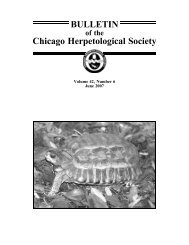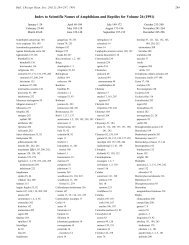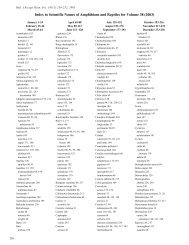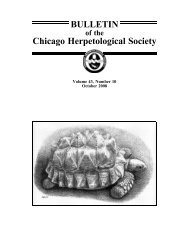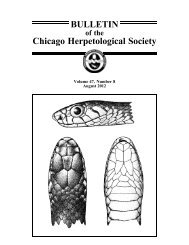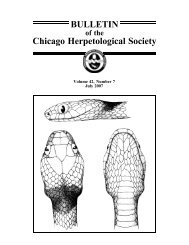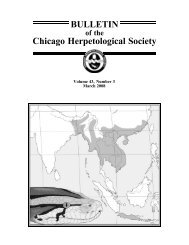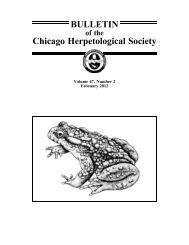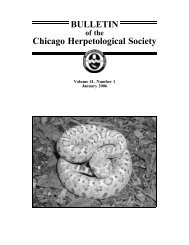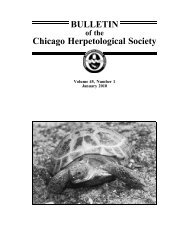April - Chicago Herpetological Society
April - Chicago Herpetological Society
April - Chicago Herpetological Society
Create successful ePaper yourself
Turn your PDF publications into a flip-book with our unique Google optimized e-Paper software.
USE OF CHEMOSENSORY CUES BY TUATARA<br />
A. A. Besson et al. [2009, J. Herpetology 43(1):124-131] note<br />
that in lizards, chemical senses play important roles in ecology<br />
and behavior. Previous studies have shown that food chemical<br />
discrimination, phylogeny and foraging modes are associated in<br />
squamates. The two major clades, Iguania and Scleroglossa,<br />
display marked differences in foraging behavior. A large majority<br />
of iguanians are primarily ambush foragers and lack prey<br />
chemical discrimination, whereas scleroglossans, mainly active<br />
foragers, are capable of prey chemical discrimination. However,<br />
evidence for prey chemical discrimination in tuatara (Sphenodon),<br />
the only living representative of the order Rhynchocephalia (the<br />
sister group of Squamata) is not clear. The authors compared<br />
responses to food chemical stimuli between tuatara (Sphenodon<br />
punctatus) and a gekkotan lizard, the common gecko (Hoplodactylus<br />
maculatus). They found that tuatara showed the same<br />
responses as common geckos when presented simultaneously<br />
with a series of stimuli: they spent more time in the prey zone<br />
(odor of mealworms) than the pungency or control zones; they<br />
bit only the prey stimulus; and they showed similar latency to<br />
bite and give-up time as geckos. However, unlike tuatara, geckos<br />
showed lingual sampling (tongue flicking) toward the prey<br />
stimulus. This study showed that tuatara could use chemosensory<br />
cues to detect prey in the absence of stimulus movement.<br />
Consequently, the coding of traits used to characterized tuatara<br />
as an outgroup in chemoreception studies should be revised.<br />
BOREAL TOAD DEMOGRAPHICS<br />
M. K. Young and D. A. Schmetterling [2009, Copeia 2009(1):<br />
117-124] note that like many species of amphibians, boreal<br />
toads (Bufo boreas boreas, Bufonidae) are declining throughout<br />
portions of their range. Recent efforts have focused on describing<br />
the ecology of this species, yet few studies have evaluated<br />
demographic characteristics that may influence the persistence<br />
of boreal toad populations. Because boreal toads often convey<br />
themselves down valleys via stream channels in some areas, the<br />
authors set upstream-facing hoop nets in early to late summer in<br />
several first- to third-order tributaries in two western Montana<br />
river basins to assess the sizes of individuals using streams and<br />
examine temporal and spatial variation in captures. They made<br />
923 captures of juvenile and adult boreal toads. Adult females<br />
were up to 125 mm snout–vent length, whereas males never<br />
exceeded 105 mm. Females tended to be heavier than males and<br />
female weights were significantly more variable. Early-summer<br />
captures were dominated by juvenile toads 70 mm; and toads of<br />
intermediate size were rare throughout. In tributaries of one<br />
river basin, captures of toads were more widely distributed in<br />
late summer than in early summer, whereas in tributaries of the<br />
other basin catches were similarly distributed in both periods.<br />
The authors infer from these patterns that frequent and perhaps<br />
far-ranging movements by juveniles and adults are typical of<br />
boreal toads in this region. They contend that netting streams in<br />
summer represents a useful complement to breeding site surveys<br />
for understanding the demographics and distribution of boreal<br />
toads, and perhaps other non-breeding amphibians near streams.<br />
PREY AVAILABILITY AND HABITAT SELECTION<br />
J. H. Sperry and P. J. Weatherhead [2009, J. Herpetology<br />
43(1):55-64] note that an animal's requirements (e.g., food vs.<br />
shelter) from its environment are likely to vary seasonally and,<br />
therefore, so too should habitat selection. The authors tested the<br />
hypothesis that Texas ratsnakes (Elaphe obsoleta) choose habitats<br />
based on prey availability during their active season and on<br />
cover during winter. They examined snake habitat selection at<br />
three spatial scales and compared that to abundance of small<br />
mammals and nesting birds, which were confirmed by diet<br />
analysis to be the snakes’ principal prey. Small mammal trapping<br />
and avian point counts showed that overall prey abundance<br />
was higher on mesas and slopes compared to savannahs. Compared<br />
to availability of habitats within the entire study area,<br />
snakes selected home ranges with a high proportion of slope<br />
habitat. Within home ranges, however, selection for slopes was<br />
exhibited only during winter when foraging is at a minimum and<br />
snakes are relatively inactive. Snakes did not use habitat within<br />
home ranges selectively during the active season or during the<br />
avian breeding season. The latter result suggests that ratsnakes<br />
are effective avian nest predators despite preying on birds opportunistically.<br />
However, it is also possible that some individual<br />
ratsnakes specialize on birds, whereas the majority preys on<br />
mammals. Microhabitat analysis comparing winter and active<br />
season sites showed that snakes preferentially used areas of high<br />
canopy cover and rock ground cover during winter. Collectively<br />
these results provide limited support for the hypothesis that<br />
ratsnakes use habitats based on prey availability but do indicate<br />
that ratsnakes select winter habitat based on cover availability.<br />
DESERT TORTOISE NUTRITION<br />
L. C. Hazard et al. [2009, J. Herpetology 43(1):38-48] note that<br />
wild desert tortoises, Gopherus agassizii, are eating different<br />
foods now than they were decades ago, because exotic plant<br />
species have invaded and flourished in the Mojave Desert over<br />
the last century. Reservations about the nutritional quality of<br />
exotic vegetation compared to native vegetation led the authors<br />
to conduct feeding experiments with growing, juvenile desert<br />
tortoises. They determined the digestibility of dry matter, energy,<br />
fiber, and nitrogen in four foods: Achnatherum hymenoides<br />
(a native grass), Schismus barbatus (an exotic grass),<br />
Malacothrix glabrata (a native forb), and Erodium cicutarium<br />
(an exotic forb). The largest nutritional differences among diets<br />
were between food types (fresh forbs and dry grasses) rather<br />
than between native and exotic species. The two grass diets<br />
were higher in fiber content and they contained less digestible<br />
energy than the two forb diets. The grasses contained little<br />
protein, and tortoises actually lost mass and body nitrogen while<br />
eating them. The exotic forb yielded more energy and nitrogen<br />
per unit dry mass than did the native forb, but this may be related<br />
to differences in phenological stages and associated fiber<br />
contents of these foods when they were collected. Juvenile<br />
tortoises gained weight rapidly when eating forbs and showed<br />
no evidence of having a lower digestive capability than did<br />
adults, despite their small size and immaturity. Estimates of<br />
nitrogen requirements compared to annual nitrogen intake on<br />
these diets suggested that growth of juveniles may be limited in<br />
part by dietary nitrogen.<br />
66



